

Finally, the best way to make sure that your computer has not been compromised with any malware is to regularly run your anti-virus software including any updates.The email made claims of a 'scurrilous and totally unfounded' nature about her husband. If you have inadvertently clicked on a link in one of these emails, or you still have concerns about the security of your bank account, you should contact your bank as soon as possible and alert them to any potential danger. Most banks have special designated teams that deal with these fake emails, and have an email address to which the fake emails can be forwarded. Do not open it or click on any links in it, and never disclose any personal information to the sender. Speaking about what to do if you have received a suspicious email from a bank, Ronan Murphy, CEO of IT Security Company Smarttech.ie said that “ the first thing to do is never reply to it. What to do if you have received a fake email? As in the image of the email received by the Bank of Ireland customer, there are simple spelling mistakes in the senders’ email address and in the body of the text. This is because, in many cases, English is not the first language of the fraudsters. Other tell-tale signs that it is a fake email is that it contains spelling mistakes. A bank will never send a customer an email requesting personal or financial information. The quickest way to spot a scam email from a bank is its very existence. Another element to the scam is that by clicking on the bogus link, malware can be secretly installed onto the users’ computer, which allows the hacker to track and record a person’s activities.


Once the hackers have your personal information, in a short time, the information is either sold onto someone else or used for fraudulent transactions. If the customer had clicked on the link, they would have been taken to a webpage run the hackers, but which would have had the appearance of being from the bank. The fraudsters attempt to lull the customer into a false sense of security by using an email address and email format which have the appearance of being from the real bank. This common form of phishing is actually a hoax.
#Fake ireland address update#
In the image of the email received by a Bank of Ireland customer last night, the fake email tried to obtain the customers’ personal information by requesting them to click on a link and update their details. They may be less likely to spot these fake emails on the smaller screen or just let their guard down.” continued Ronan Murphy CEO of IT Security Company Smarttech.ie.Īn image of one of the fake emails received by Irish consumers in the past number of weeks “One reason why there has been a spike in these phishing scams over the last few weeks is that many Irish people are abroad on their holidays and could be relying on their phone to read their emails. The cyber criminals involved are experts scam artists who operate with extreme precision, meaning this recent trend of increases is not a random occurrence.” These scams are not unique to Bank of Ireland and have been experience by all the major banks across the world. Ronan Murphy CEO of IT Security Company Smarttech.ie has warned that “ There has been an increase in these types of phishing scams being reported to Smarttech.ie over the past several weeks and we would like to further warn the public as anyone can be a vulnerable target. Known as “phishing scams”, these fake emails appear to be legitimate and are aimed at tricking the customer into handing over personal or sensitive financial information to cyber criminals. According to IT security firm, Smarttech.ie, fake emails purporting to be from Irish banks have been on the rise over the last couple of weeks.


 0 kommentar(er)
0 kommentar(er)
